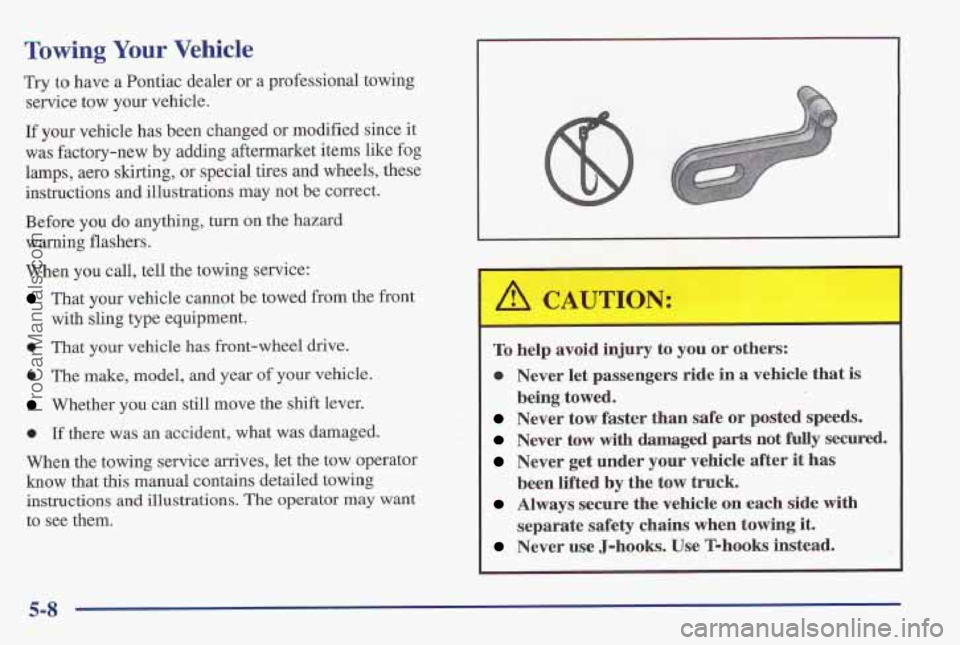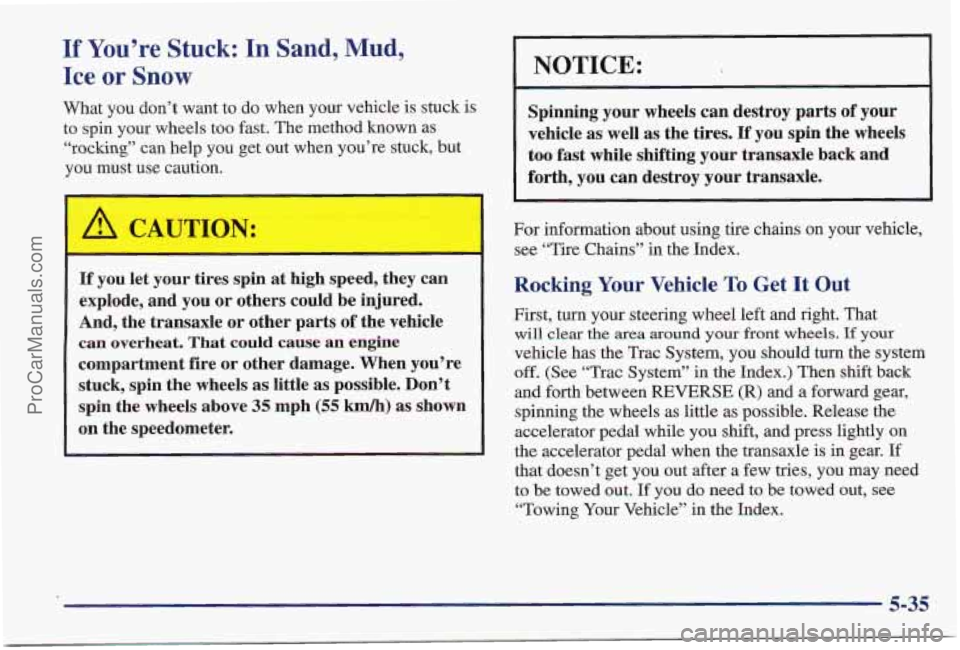Page 235 of 419
Section 5 Problems on the Road
Here you’ll find what to do about some problems that can occur on the road.
5-2
5-2
5-3
5-8
5-9
5-11
5-1 3
5-13
How to Use Warning Flashers
Other Types
of Warning Devices
Step-by-step Procedure for Jump Starting
Information
You Should Know Before Towing
Towing Your Vehicle From the Front
Towing Your Vehicle From the Rear
If Your Engine is Overheating
If Steam is Coming From Your Engine
5- 15
5- 17
5-23
5 -24
5-32
5-34
5-35
5-35 Cooling System
How to
Add Coolant
What to do if
a Tire Goes Flat
How to Change
a Flat Tire
Where to Store the Flat Tire and Tools
Information on the Compact Spare Tire
If You’re Stuck in Sand, Mud,
Snow or on Ice
How to Rock Your Vehicle to Get Unstuck
ProCarManuals.com
Page 242 of 419

Towing Your Vehicle
Try to have a Pontiac dealer or a professional towing
service tow your vehicle.
If your vehicle has been changed or modified since it
was factory-new by adding aftermarket items like fog
lamps, aero skirting, or special tires and wheels, these
instructions and illustrations may not
be correct.
Before you
do anything, turn on the hazard
warning flashers.
When you call, tell the towing service:
That your vehicle cannot be towed from the front
with sling
type equipment.
0 That your vehicle has front-wheel drive.
0 The make, model, and year of your vehicle.
Whether you can still move the shift lever.
0 If there was an accident, what was damaged.
When the towing service arrives, let
the tow operator
know that this manual contains detailed towing
instructions and illustrations.
The operator may want
to see them.
r
I
To help avoid injury to you or others:
0 Never let passengers ride in a vehicle that is
Never tow faster than safe or posted speeds.
Never tow with damaged parts not fully secured.
Never get under your vehicle after it has
been lifted by the tow truck.
Always secure the vehicle on each side with
separate safety chains when towing it.
Never use J-hooks. Use T-hooks instead.
being towed.
5-8
ProCarManuals.com
Page 243 of 419

,-., ., . ........
A vehicle can fall from a car carrier if it isnst" .,''.' ''.
adequately secured. This can cause a collision,
serious personal injury and vehicle damage. The
vehicle should be tightly secured
with chains or
steel cables before
it is transported.
Don't use substitutes (ropes, leather straps,
canvas webbing, etc.) that can be cut by sharp
edges underneath the towed vehicle. Always use
T-hooks inserted in the T-hook slots. Never use
J-hooks. They will damage drivetrain and
suspension components.
When your vehicle is being towed, have the ignition
turned to the
OFF position. The steering wheel should
be clamped in
a straight-ahead position, with a
clamping device designed for towing service.
Do not
use the vehicle's steering column lock for this. The
transaxle should be in
NEUTRAL (N) and the parking
brake released. Don't have your vehicle towed on the front
wheels,
unless you must.
If the vehicle must be towed on the
front wheels,
be sure to follow the speed and distance
restrictions later in this section or your transaxle will be
damaged.
If these limitations must be exceeded, then the
front wheels have to be supported
on a dolly.
Front Towing
ProCarManuals.com
Page 244 of 419
NOTICE:
Do not tow with sling-type equipment or
fascidfog lamp damage will occur. Use wheel-lift
or car carrier equipment, Additional ramping
may
be required for car carrier equipment. Use
safety chains and wheel straps.
Towing a vehicle over rough surfaces could
damage
a vehicle. Damage can occur €.om vehicle
to ground or vehicle
to wheel-lift equipment. To
help avoid damage, raise the vehicle until
adequate clearance
is obtained between the
ground and/or wheel-lift equipment.
Do not attach winch cables or Jnhooks to
suspension components when using car carrier
equipment. Always use T-hooks inserted in the
T-hook slots.
Attach T-hook chains in the
front brackets
of the cradle,
ow both sides.
These slots are to be used when loading and securing to
car carrier equipment.
5-10
ProCarManuals.com
Page 245 of 419
Attach a separate safety chain around the outboard end
of each lower control arm.
Rear Towing
A towing dolly must be used under the drive wheels when
towing from the real:
Note: Take care not to damage speed sensor wires when
attaching chains.
Use wheel lift or car carrier equipment. Additional
ramping may
be required for car carrier equipment. Use
safety chains and wheel straps.
5-11
ProCarManuals.com
Page 246 of 419
NOTICE:
Do not tow with sling-type equipment or the rear
bumper fascia will be damaged.
Towing a vehicle over rough surfaces could
damage
a vehicle. Damage can occur from
vehicle to ground or vehicle to wheel-lift
equipment,
To help avoid damage, install a
towing dolly and raise the vehicle until adequate
clearance
is obtained between the ground and/or
wheel-lift equipment.
Do not attach winch cables or J-hooks to
suspension components when using car carrier
equipment. Always
use '6-books inserted in the
T-hook slots.
Attach T-hook chains to the T-hook slots in the
floor pan support rails, just ahead of the rear wheels,
on both sides.
These slots are to be used when loading and securing to
car carrier equipment.
5-12
ProCarManuals.com
Page 269 of 419

If You’re Stuck: In Sand, Mud,
Ice or
Snow
What you don’t want to do when your vehicle is stuck is
to spin your wheels too fast. The method known as
“rocking” can help you get out when you’re stuck, but
you must use caution.
L
If you let your tires spin at high speed, they can
explode, and you or others could be injured.
And, the transaxle or other parts
of the vehicle
can overheat. That could cause an engine
compartment fire or other damage. When you’re
stuck, spin the wheels
as little as possible. Don’t
spin the wheels above
35 mph (55 km/h) as shown
on the speedometer.
NOTICE:
Spinning your wheels can destroy parts of your
vehicle as well as the tires.
If you spin the wheels
too fast while shifting your transaxle back and
forth, you can destroy your transaxle.
For information about using tire chains on your vehicle,
see “Tire Chains” in the Index.
Rocking Your Vehicle To Get It Out
First, turn your steering wheel left and right. That
will clear the area around your front wheels. If your
vehicle has the Trac System, you should turn the system
off. (See “Trac System” in the Index.) Then shift back
and forth between REVERSE (R) and
a forward gear,
spinning the wheels as little as possible. Release the
accelerator pedal while you shift, and press lightly on
the accelerator pedal when the transaxle
is in gear. If
that doesn’t get you out after a few tries, you may need
to be towed
out. If you do need to be towed out, see
“Towing Your Vehicle” in the Index.
ProCarManuals.com
Page 291 of 419

How to Check and Add Oil
Check oil only when the engine is cold. Allow the
engine to cool two to three hours after running.
If you remove the supercharger oil fill plug while
the engine is hot, pressure may cause hot oil to
blow out
of the oil fill hole. You may be burned.
DQ not remove the plug until the engine cools.
1. Clean the area around the oil fill plug before
removing it.
2, Remove the oil fill plug using a 3/16 inch
Allen wrench.
5. The oil level is correct when it just reaches the
bottom of the threads
of the inspection hole.
4. Replace the oil plug with the O-ring in place.
Torque to 88
lb-in (10 N.m).
Automatic Transaxle Fluid
When to Check and Change
A good time to check your automatic transaxle fluid
level is when the engine oil is changed.
Change both the fluid and filter every
50,000 miles
(83
000 km) if the vehicle is mainly driven under one or
more of these conditions:
In heavy city traffic where the outside temperature
regularly reaches
90 OF (3 2 O C) or higher.
0 In hilly or mountainous terrain.
0 When doing frequent trailer towing.
Uses such as found in taxi, police or delivery service.
If you do not use your vehicle under any of these
conditions, the fluid and filter do not require changing.
See “Scheduled Maintenance Services” in the Index.
ProCarManuals.com